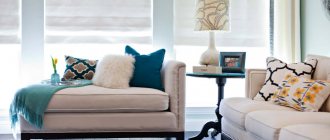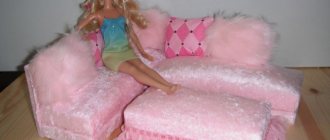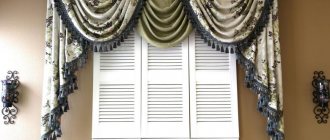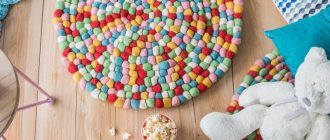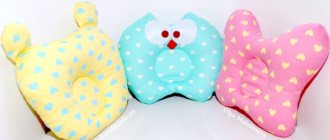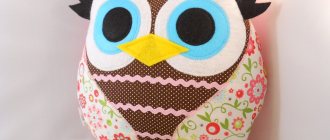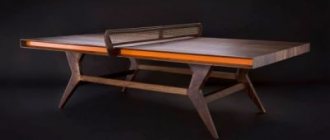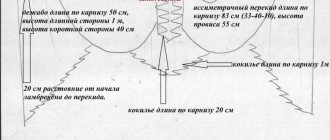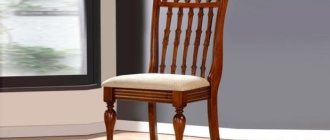Beautiful decorative pillows can enliven even the most restrained interior. They bring an atmosphere of comfort, home warmth and allow you to relax. You don’t have to spend a lot of money to decorate your home with them, because you can create these cute decorative elements yourself.
We have selected thematic master classes for you, from which you will learn how to sew the pillow of your dreams. Thanks to step-by-step photographs and detailed descriptions, even a beginner can cope with this.
Using decorative pillows
The bedroom is not the main place for pillows. The cushion base is suitable for creating soft parts of furniture. In the kitchen, their location in corner structures is ideal. This will make sitting at the table much more comfortable.
Choose space for decoration outside the walls of the apartment. This type of textile is also placed in the gazebo in the garden. Do you have an open veranda? Fill it with comfort with pillows.
The interior is changing before our eyes. You can play with its severity by using textures, colors and prints of decorative items. Decor consists of decorating the upholstery of products - covers. It is necessary to create on them.
Pillows are applicable everywhere. They will not be superfluous on armchairs, chairs, sofas and other relaxation spaces. Textiles set the style of the room. The predominance of marine motifs in the room can be reflected in the pillow.
It contains images of the sea, shells, marine life and bluish colors predominate. Children's original pillows, calm products for the living room or bright kitchen pillows will allow your imagination to run wild.
Some tips
Making a simple pattern will not cause any difficulties, but for more complex shapes you can use ready-made templates that are easy to find on the Internet or in specialized magazines.
Don't forget to leave seam allowances.
A standard pillowcase has a size of 70*70 or 70*50, so if you don’t want to make special covers later, it’s better to make pillows based on these characteristics.
To reduce the number of seams, a rectangular pillow can be sewn not from two fabrics, but from one, making a fold in the middle of the fabric.
It is much more convenient to fill a pillow from synthetic materials, but fluff can scatter throughout the room if you move it carelessly. It is carefully poured from the old pillow or factory packaging through the holes of the old and new down storage sewn together.
A small incision is left to fill the pillow.
If you plan to sew in a zipper, then this element should be selected with tiny locks and teeth. Otherwise, the zipper can dig into the skin and cause a lot of inconvenience.
Knitted pillows
Knitting covers for soft goods is extremely easy. Such things emanate warmth and comfort. Designers advise using knitting for Scandinavian interior options.
- Original pillows are crocheted and knitted.
- The master chooses the appropriate tool for himself. The place to relax is transformed by pillows.
- The patterns on them and the use of light yarn are ideal for promoting calm.
- The challenge is to invent an accent color? Your choice should fall on bright, unusual thread tones.
Boring furniture will be decorated with original objects.
Upholstery reupholstery
Covering the module is not a labor-intensive process, but requires care. First, you need to take into account that you will need two covers for pillows: internal and external. One closes the module structure, giving it a complete look, the second performs a decorative function. The first cover is made of coarse textile, characterized by good strength and density. The second fabric should also be dense, but also beautiful, fitting into the interior.
To make the process easier, you can rip open the old cover and, if there is no zipper, add an allowance. Having ironed the material, it is measured so as not to buy excess fabric, then the required amount of material is purchased and cut out in compliance with the direction of the grain thread. You should not add allowances other than those that already exist: the fit of the textile should be as tight as possible: sliding of the textile or its sagging is unacceptable, as this will lead to the formation of folds and loss of attractive appearance.
If desired, the cover can consist of more than just textiles. Sometimes a layer of synthetic padding is added to it, connecting it to the upholstery with decorative stitches. Often the cover is decorated not only with stitching, but also with finishing piping or cord.
Choosing a pillow for a sofa is a topic that worries many people. Having a good foundation, you don’t want to throw away furniture just because the modules are worn out. Repairing pillows will change the style of the interior and extend the life of the sofa.
An example of self-upholstery of a sofa (restoration of soft parts, replacement of upholstery fabric and strengthening of the main furniture frame) is in the video.
Cushions on a sofa are an integral part of the interior. The combination of design colors speaks about the subtleties of taste of the owner of the house. And the shape characterizes the personal characteristics of the owner. Handmade rollers will fill your home with coziness and will certainly delight your guests.
Sofa cushions provide comfort and coziness and help place color accents in the interior
Wool thread pillows
Children's products are created from this knitting material. Animal figures are most often crocheted. How cute the sheep look! Children will use them more often than other pillows. They will be attracted by the unusual appearance of the products.
Such textile objects can be perceived as toys. In the process of creating decorative pillows, you will simultaneously decorate the room and create figurines for children.
As a result, you will purchase original pillows that can be used as toys. A good mood is guaranteed.
Design options
Here you need to give free rein to your imagination. Ideas can be very diverse, as well as techniques. Suitable decorations:
- satin ribbons, bows;
- sequins and beads;
- lace and embroidery.
It is worth taking a closer look at such popular technologies as applique and patchwork.
Puffs are a particularly impressive finish. There can be a lot of options. In any case, such pads look quite attractive and elegant.
An equally original design technique is ribbon embroidery. The result looks gentle and romantic. And the creation process itself is simple enough to be feasible for beginners.
If you want to make something truly special and stylish, play with different textures or combine several techniques at once.
Decorating covers with threads
Many people do not want to knit due to lack of proper skills and time. Then you can make pompoms from threads.
You will need:
- Cardboard,
- Yarn,
- Scissors.
Stages of work:
- The material is wound onto a cardboard blank.
- Having reached the desired volume, the thread is secured.
- Then you need to make a slit so that the appearance resembles a pompom.
- Now, the decoration is ready. Even a child can handle it. Neutrality inside the room is minimized.
Which padding to use
- It is strictly not recommended to use cotton wool as a filler - heavy and poorly distributed material can ruin all the painstaking work. So even if the only advantage is cheapness, this option should be discarded.
- Sintepon is an excellent replacement for foam rubber. Does not cause an allergic reaction, does not produce a greenhouse effect, an easy and inexpensive alternative. This type of filler can be easily crushed, but the previous shape will be immediately restored. However, a long period of use is not good for padding polyester; over time it can fall into clumps, which will spoil the appearance of the finished product.
- Fans of down and feathers will be disappointed, since they are best intended for sleeping, but not for decorative elements. Moreover, they can also cause allergies.
- Holofiber is currently one of the best types of fillers. Thanks to the structure of the threads in the composition, it is able to quickly take its previous shape, regardless of the severity of the load in the past, which is convenient for orthopedic products and comfortable for pregnant women.
The texture of the pillows
The pillows are also decorated with fabric, which is adjusted to fit the specified recesses. Everything is used, from folds to weaving and adding bows. In the process, pay attention to the photos of homemade pillows.
There is an option for the laziest - wrapping the pillow completely tightly, which is secured only at the very end. The result is a unique design.
Ruffles are added to this picture. The former ordinariness of the subject remains a thing of the past. Beginners should prove themselves in this technique.
Selection of material for sewing
Careful selection of material should be made for sewing a cover or pillowcase. The material of the sleeping pillow must be made of high-quality fabrics and not contain allergens or toxic dyes.
The textile fabric must be resistant to frequent washing, and, if possible, have an additional antistatic layer. The most optimal fabrics today are recognized as:
Note!
DIY feeder - step-by-step instructions for creating a feeder + detailed diagrams with photo reviewsDo-it-yourself rugs - TOP 120 simple patterns with master classes on how to make them yourself + photo reviews of finished rugs
Do-it-yourself dolls: a master class on making a beautiful doll. Simple instructions with photo examples of ready-made options
- Silk fabric. Natural fabric with a pleasant structure. It is an excellent material for sleeping pillows. A significant drawback is the special requirements for practical care.
- Linen. Another representative of natural fabrics, characterized by increased strength and no maintenance requirements. Fabric made from natural threads allows air to pass through well and does not absorb unpleasant odors. A small percentage of the addition of synthetic threads increases the fabric's resistance to frequent washing and possible shrinkage.
- Cotton. An excellent basis for creating stylish pillows, both decorative and sleeping models.
- For warm winter pillows, you can use woolen fabric, which will make a warm and beautiful pillow for the bedroom.
For sewing decorative accessories, synthetic fabrics are often used, which have bright colors, sufficient strength and an antistatic layer.
Felt for decorating pillows
Felt parts assembled into a single figure serve as an excellent decor for pillows. Parts of the product will not ask you to secure the edges. This is the advantage of the material.
Without much effort, you give the room lightness. The best craft is to create different colors.
Preparing patterns
Today, on various web resources and practical needlework magazines, you can find a wide variety of patterns for sewing pillows of all sizes and shapes. But if desired, the master can independently think through the future design of the accessory.
In this case, the drawing must show the dimensions, main details of the future cover, and the presence of auxiliary elements (inserts, modules).
Application
Use everyday products for applications. After creative activity, the masters have in their arsenal deposits of beads, fabric and jewelry in the form of sparkles.
Realize their second life in crafts. Create the appearance of the product in your head before starting work.
Keep in mind that the idea must be combined with the rest of the interior components. It shouldn't look alone. To avoid mistakes, make universal pillows.
Preparing the main parts
On the wrong side of the prepared fabric, draw the main details, outlining their contours with chalk. Be sure to leave 2-3 cm for seam rows. The parts are sewn together with the wrong side out, leaving a small window for the filler.
Next, turn the cover right side out, and then begin stuffing the pillow with batting or feathers. The last step is to close the remaining window.
Buttons
Involve your children in the decorating process. All you need is the pillow itself, a little creativity, buttons and glue. Yes, you understood everything correctly.
We present to your attention a safe way to fasten parts. Activities with your child will strengthen the bond between you and create unique items for the rooms.
Fluffy pillow
Fringe is used infrequently. It’s a shame, because she looks presentable. Children's original pillows are very soft to the touch. You just want to lie on them.
Necessary materials:
- Fleece is intended for the base of the product and for creating fringe;
- Sintepon or any other filling;
- Scissors;
- Sewing threads;
- Pins;
- A sewing machine that will provide excellent quality.
Stages of work:
- The first step is to cut the fabric into strips. It is worth bending them into two parts. Dedicate yourself to the process of cutting the fringe.
- The parts are sewn to the pillow with an indentation of one cm. Next, the fringe is tensioned in one direction.
- Step back 1.5 centimeters from the previous strip and place the second element there. The following steps will be performed according to the given analogy.
- This way the pillow will be covered with fringe in a short time.
Patterns of the original pillow and diagrams can be found in any sources. It is important to adhere to the correct sequence of actions and compliance with the availability of inventory. Even the most shocking solutions from the first point of view can become the best decor for a room.
There should be no fear of everything new. Beginners will have a chance to express themselves in new activities. Feel the strength to be creative; this charge must come from within. Do not try to recreate exact copies of template options.
The essence of any creativity is the manifestation of imagination using various available means.
Materials and tools for work
For the master class you need to prepare the following set of materials:
- Threads, needles, scissors.
- Sewing machine for line stitches.
- Working material for sewing a cover.
- Patterns.
- Chalk.
- Filler (batting).
Also, great attention should be paid to the organization of the workplace: a tabletop with wide edges, a chair and the level of lighting.
Note!
DIY satin ribbon bows - step-by-step instructions for creating unusual bows + detailed diagrams with photos- Do-it-yourself furniture restoration: step-by-step master classes on restoration at home (120 photo ideas)
Do-it-yourself rack: step-by-step instructions with photos and descriptions on how to make an unusual rack
